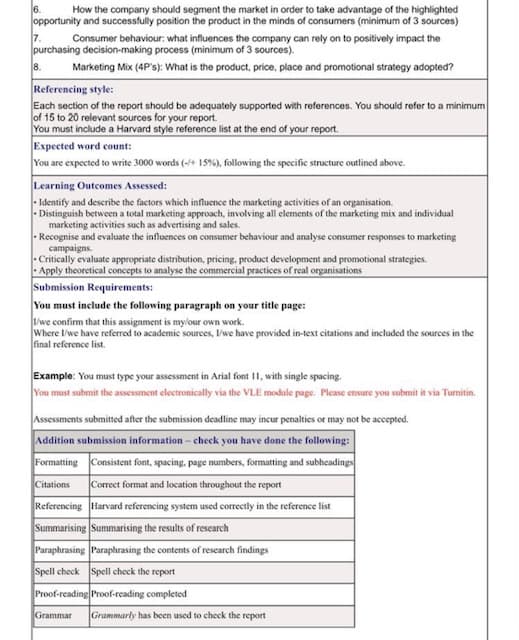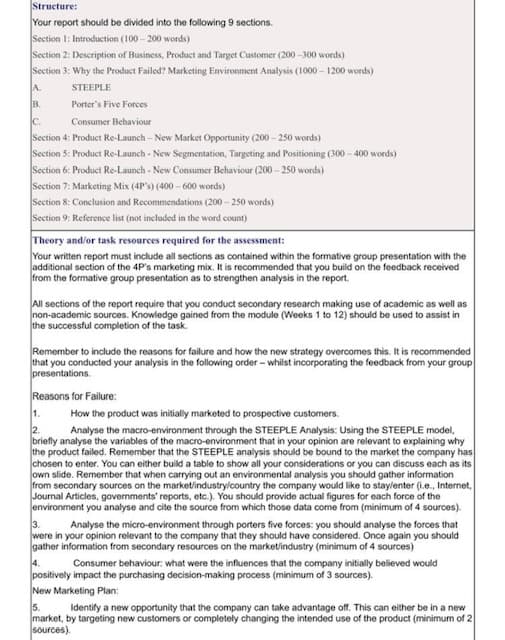Principles Of Marketing
17th Edition
ISBN:9780134492513
Author:Kotler, Philip, Armstrong, Gary (gary M.)
Publisher:Kotler, Philip, Armstrong, Gary (gary M.)
Chapter1: Marketing: Creating Customer Value And Engagement
Section: Chapter Questions
Problem 1.1DQ
Related questions
Question
case study about watermelon oreo, why its failed

Transcribed Image Text:6.
opportunity and successfully position the product in the minds of consumers (minimum of 3 sources)
How the company should segment the market in order to take advantage of the highlighted
7.
purchasing decision-making process (minimum of 3 sources).
8.
Consumer behaviour: what influences the company can rely on to positively impact the
Mix (4P's): What is the product, price, place and promotional strategy adopted?
Referencing style:
Each section of the report should be adequately supported with references. You should refer to a minimum
of 15 to 20 relevant sources for your report.
You must include a Harvard style reference list at the end of your report.
Expected word count:
You are expected to write 3000 words (-/+ 15%), following the specific structure outlined above.
Learning Outcomes Assessed:
- Identify and describe the factors which influence the marketing activities of an organisation.
- Distinguish between a total marketing approach, involving all elements of the marketing mix and individual
marketing activities such as advertising and sales.
- Recognise and evaluate the influences on consumer behaviour and analyse consumer responses to marketing
campaigns.
- Critically evaluate appropriate distribution, pricing, product development and promotional strategies.
- Apply theoretical concepts to analyse the commercial practices of real organisations
Submission Requirements:
You must include the following paragraph on your title page:
Iwe confirm that this assignment is mylour own work.
Where l'we have referred to academic sources, I'we have provided in-text citations and included the sources in the
final reference list.
Example: You must type your assessment in Arial font 11, with single spacing.
You must submit the assessment electronically via the VLE module page. Please ensure you submit it via Turnitin.
Assessments submitted after the submission deadline may incur penalties or may not be accepted.
Addition submission information - check you have done the following:
Formatting Consistent font, spacing, page numbers, formatting and subheadings
Correcet format and location throughout the report
Referencing Harvard referencing system used correctly in the reference list
Citations
Summarising Summarising the results of research
Paraphrasing Paraphrasing the contents of research findings
Spell check Spell check the report
Proof-reading Proof-reading completed
Grammar
Grammarly has becen used to check the report

Transcribed Image Text:Structure:
Your report should be divided into the following 9 sections.
Section 1: Introduction (100 – 200 words)
Section 2: Description of Business, Product and Target Customer (200 -300 words)
Section 3: Why the Product Failed? Marketing Environment Analysis (1000 – 1200 words)
A.
STEEPLE
B.
Porter's Five Forces
C.
Section 4: Product Re-Launch – New Market Opportunity (200 – 250 words)
Section 5: Product Re-Launch - New Segmentation, Targeting and Positioning (300 -400 words)
Section 6: Product Re-Launch - New Consumer Behaviour (200 – 250 words)
Section 7: Marketing Mix (4P's) (400 - 600 words)
Section 8: Conclusion and Recommendations (200 – 250 words)
Section 9: Reference list (not included in the word count)
Consumer Behaviour
Theory and/or task resources required for the assessment:
Your written report must include all sections as contained within the formative group presentation with the
additional section of the 4P's marketing mix. It is recommended that you build on the feedback received
from the formative group presentation as to strengthen analysis in the report.
All sections of the report require that you conduct secondary research making use of academic as well as
non-academic sources. Knowledge gained from the module (Weeks 1 to 12) should be used to assist in
the successful completion of the task.
Remember to include the reasons for failure and how the new strategy overcomes this. It is recommended
that you conducted your analysis in the following order – whilst incorporating the feedback from your group
presentations.
Reasons for Failure:
1.
2.
briefly analyse the variables of the macro-environment that in your opinion are relevant to explaining why
the product failed. Remember that the STEEPLE analysis should be bound to the market the company has
chosen to enter. You can either build a table to show all your considerations or you can discuss each as its
own slide. Remember that when carrying out an environmental analysis you should gather information
from secondary sources on the market/industry/country the company would like to staylenter (i.e., Internet,
Journal Articles, governments' reports, etc.). You should provide actual figures for each force of the
environment you analyse and cite the source from which those data come from (minimum of 4 sources).
How the product was initially marketed to prospective customers.
Analyse the macro-environment through the STEEPLE Analysis: Using the STEEPLE model,
3.
were in your opinion relevant to the company that they should have considered. Once again you should
gather information from secondary resources on the marketindustry (minimum of 4 sources)
Analyse the micro-environment through porters five forces: you should analyse the forces that
4.
positively impact the purchasing decision-making process (minimum of 3 sources).
New Marketing Plan:
Consumer behaviour: what were the influences that the company initially believed would
Identify a new opportunity that the company can take advantage off. This can either be in a new
5.
market, by targeting new customers or completely changing the intended use of the product (minimum of 2
sources).
Expert Solution
This question has been solved!
Explore an expertly crafted, step-by-step solution for a thorough understanding of key concepts.
This is a popular solution!
Trending now
This is a popular solution!
Step by step
Solved in 2 steps

Recommended textbooks for you

Principles Of Marketing
Marketing
ISBN:
9780134492513
Author:
Kotler, Philip, Armstrong, Gary (gary M.)
Publisher:
Pearson Higher Education,

Marketing
Marketing
ISBN:
9781259924040
Author:
Roger A. Kerin, Steven W. Hartley
Publisher:
McGraw-Hill Education

Foundations of Business (MindTap Course List)
Marketing
ISBN:
9781337386920
Author:
William M. Pride, Robert J. Hughes, Jack R. Kapoor
Publisher:
Cengage Learning

Principles Of Marketing
Marketing
ISBN:
9780134492513
Author:
Kotler, Philip, Armstrong, Gary (gary M.)
Publisher:
Pearson Higher Education,

Marketing
Marketing
ISBN:
9781259924040
Author:
Roger A. Kerin, Steven W. Hartley
Publisher:
McGraw-Hill Education

Foundations of Business (MindTap Course List)
Marketing
ISBN:
9781337386920
Author:
William M. Pride, Robert J. Hughes, Jack R. Kapoor
Publisher:
Cengage Learning

Marketing: An Introduction (13th Edition)
Marketing
ISBN:
9780134149530
Author:
Gary Armstrong, Philip Kotler
Publisher:
PEARSON


Contemporary Marketing
Marketing
ISBN:
9780357033777
Author:
Louis E. Boone, David L. Kurtz
Publisher:
Cengage Learning